Emerging threats

We support organisations striving to build a trustworthy, safe online environment where users can engage authentically in their communities.
Cross-sector corporatesWe support international government organisations and NGOs working to provide infrastructure or improve the capabilities, security and resilience of their nation.
International programmes and developmentWe support commercial organisations operating in a digital world, seeking to protect their reputation and prevent business disruption caused by cyber attacks and compliance breaches.
UK government and public sectorWe support UK government organisations responsible for safeguarding critical infrastructure, preserving public trust, and maintaining national security.



The recent online response from inauthentic social media accounts to the events at the Sarah Everard vigil highlights the ongoing and increasing danger of malign trolling activities and their ability to tarnish the reputation of public figures and leverage topical political issues to further conspiratorial and extremist narratives. The swift response of the identified accounts also demonstrates the opportunistic nature of fringe inorganic trolls and their ability to derail dialogues about sexism, gender-based violence, and police brutality.
Shortly after the highly publicised arrest of Patsy Stevenson on 13 March 2021, a group of trolls began seeding information about her experience as an actress on Twitter, in an attempt to tarnish her reputation and derail the media narrative emerging around Sarah Everard’s vigil.
The news was quickly accompanied with disinformation claiming Stevenson was a hired crisis-actor who has appeared as a fake-victim in other alleged ‘false-flag’ events orchestrated by political elites.
PGI discovered that some of the profiles responsible for amplifying this content were inorganic troll accounts with pseudonymous identities and a history of antagonistic hyper-partisan activity. The accounts frequently support extreme right-wing narratives and harmful conspiracy theories, while proactively exploiting topical news stories to spread divisive messages and disinformation.
Organic media entities further amplified these accusations, featuring news of Stevenson’s past as an actress in headlines and news segments. The information gathered such momentum that Stevenson had to address the claims during her appearance on Good Morning Britain.
The tragic news of Sarah Everard’s murder has been met with widespread shock and dismay, prompting many women to share their experiences of sexual assault, harassment and microaggressions on social media. Hashtags such as #reclaimthestreets, #notallmenbutallwomen, and #educateyoursons quickly became viral and challenged men to rethink how they engage with and support women, and to shift the narrative away from the habitual victim blaming that commonly proceeds instances of gender-based violence.
Thousands attended a vigil for Sarah at Clapham Common on 13 March, which resulted in a heavy-handed police crackdown that provoked significant public anger and condemnation. Four attendees were arrested for public order offences.
One of the attendees, 28-year-old Patsy Stevenson, was photographed being restrained by policemen before her arrest. Photos of Stevenson’s arrest quickly went viral, and she became a figurehead in the movement against gender-based violence and police brutality.
Despite large volumes of support for Stevenson and other attendees of the vigil on social media, inorganic far-right trolls have been amplifying misleading claims about Stevensonin an attempt to undermine her credibility and inflame domestic political tensions.
Specifically, several accounts have shared screenshots of Stevenson’s Casting Now profile, where she is listed as an actor, presenter, and model.

Discussion and promotion of Stevenson’s Casting Now account led mainstream news coverage to refer to her as an actress and model. However, descriptive references to Stevenson as an actress at the time of writing were significantly overshadowed by users doubting her sincerity and accusing her of being a crisis actor or an infiltrator, using words including “publicity”, “troublemaker”, “infiltrate”, “plant” (a term for an undercover operative) “truth”, “conspiracy” and “exposure”. These discussions on Twitter have also brought Stevenson into wider discussions speculating about her relationship with Labour and Black Lives Matter (BLM).

News of Stevenson’s Casting Now account was frequently accompanied by the defamatory narrative that she is a failed actress and an attention seeking opportunist, acting to further the political interests of Labour, Antifa, and Black Lives Matter.


Additional inflammatory Tweets accuse Stevenson of being a crisis-actor hired by left-wing groups to infiltrate the vigil and vilify the police.
The concept of a crisis-actor is a core component of false-flag conspiracy theories, particularly in the United States, where government or left-wing groups are believed to plant fake bystanders to fabricate outrage and victimhood that dominates mainstream coverage of a traumatic event, such as a mass-shooting or a violent protest, in order to push a political agenda or conduct covert psychological operations.
The crisis actor narrative has even been extended to Sarah Everard herself, citing baseless photo-evidence which claims to show Everard attending her own vigil.

Various threads also attempt to corroborate these accusations by falsely claiming that Stevenson had previously appeared as a crisis-actor pretending to be a victim of the 2017 Parsons Green bombing in London.
This comparison however was quickly met with criticism and was debunked by organic users in the thread.

Despite this resistance, inorganic users proceeded to jump on this accusation and reshare disinformation about Stevenson’s role as a crisis-actor.
Unlike coordinated bots, or botnets, trolls can operate in isolation as well as in groups. Trolls can be real individuals dedicated to the inorganic promotion of an ideology, disrupting opposing political movements, or simply to harass, annoy and provoke backlash from other web users.
While there isn’t much evidence of automation or coordination between the accounts spreading disinformation about Stevenson, the users share common features of fringe antagonistic isolated trolls, including:
1.Activity across multiple accounts (with evidence of previous suspensions and platform migration, e.g. by advertising their GAB handle).

2. Pseudonymous names and handles.
3. Non personally identifying profile pictures (Generative Adversarial Network – GAN – photos, cartoons, celebrities, animals, or no picture at all).
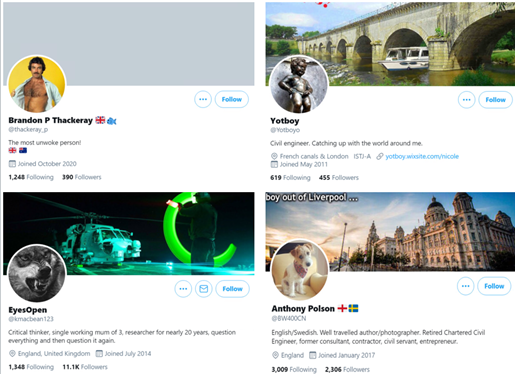
One of the inauthentic accounts amplifying this content used a GAN profile picture commonly used by malicious bots and trolls to mask their identity while making their activity seem organic.
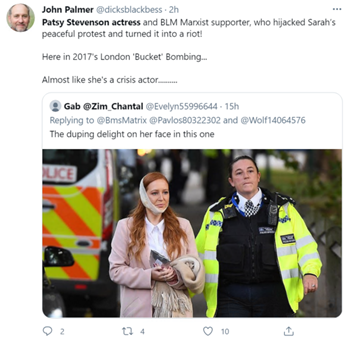
GANs are algorithmically generated photos, built by neural networks which use thousands of pictures of real people to create artificial faces. GANs utilise processed facial photos that have been centred, scaled, and cropped, resulting in a symmetrical alignment of facial features such as eyes, nose, and mouth. This symmetry can be observed when comparing across multiple GANs.

The above profile has been active since February 2020, and proactively posts antisemitic and neo-Nazi content, in addition to media related to race-realism, white-genocide, and QAnon.
4. Repetitive resharing of media to high-profile accounts.
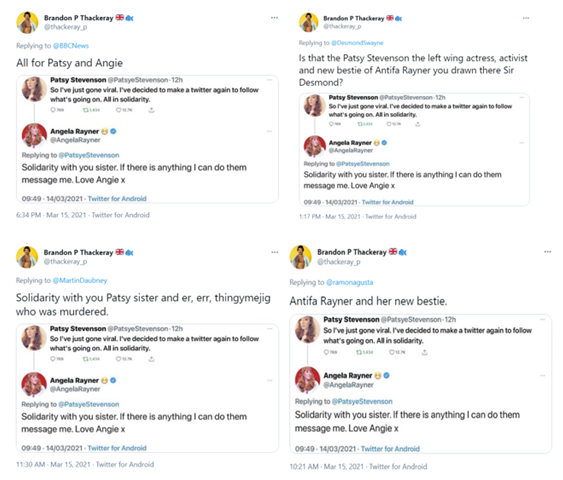
5. High volume of replies and retweets.
6. Sole focus on salient political wedge-issues, e.g. the royal family, Brexit, Trump, COVID-19 vaccines, and lockdowns
By framing her as a crisis actor, the trolls have also made the events of Saturday’s vigil vulnerable to the extremist rhetoric of fringe anti-vax, anti-government, and even QAnon and white-genocide proponents who interpret the vigil, and Sarah Everards murder, in a manner consistent with their hostile and potentially violent worldviews.
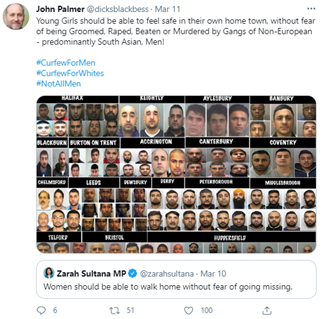
The accounts sharing conspiracy theories about Stevenson have also been observed to respond to Everard’s murder in a way that tries to make people seem hypocritical, and in a way that allows them to switch the narrative and broadcast their racist beliefs. This kind of opportunistic exploitation of topical news stories is a core strategy of malign influence campaigns.
Trolls seek to influence and disrupt political dialogues from the periphery, by sharing inflammatory statements and rumours that can derail a social movement or inflame political tensions.
Trolls are also highly reactive and opportunistic in their exploitation of events and media, while relying on any means of amplification to make their statements go from the margins to the centre of a discussion.
By amplifying these accusations, these trolls have successfully attacked Stevenson’s reputation. The rumours, originating on Twitter, have prompted enough people to Google “Patsy Stevenson actress”, that it is now one of the first autocomplete suggestions on the engine’s search bar.
When it comes to countering malign influence activities like this, it is important to acknowledge the role that the broader media-ecosystem plays in allowing it to flourish. News outlets in particular must consider that trolls rely on the viral influence of legitimate news organisations to give more legitimacy to a rumour instead of relying on their own hyper partisan networks and echo chambers alone. This is especially the case for fringe and potentially isolated troll accounts, like the ones targeting Stevenson, who may lack the infrastructure and community to give viral weight to a rumour by themselves.
In the case of Patsy Stevenson, trolls planted the screenshots of Stevenson’s Casting Now profile in enough places for it to be picked up by organic users, which eventually generated a big enough conversation on social media for it to be noticed by news sites, who went on to exponentially increase the reach of the rumours by mentioning it in their coverage of Stevenson’s arrest at Sarah Everard’s vigil. PGI identified almost 300 news articles referencing the rumours in the week following the vigil, with a potential audience reach of over 500 million views.
News outlets must do more to investigate the origins of social media rumours, in order to avoid inadvertently amplifying the malign influence efforts of extremist trolls. Journalists should conduct greater due diligence to uncover the genesis of a rumour or a piece of information, and whether the source account might have hostile political intentions, or if amplifying their content would compromise the integrity of an individual’s reputation or a political dialogue.
Subscribe to our Digital Threat Digest, daily insights from the PGI team into disinformation, misinformation, and online harms.
PGI’s Digital Investigations team work with both public and private sector entities to help them understand how social media can affect their business. From high level assessments of the risks of disinformation to electoral integrity in central Africa to deep dives into specific state-sponsored activity in eastern Europe we have applied our in-house capability globally.
Contact us to talk about your requirements.

Last week, the WeProtect Global Alliance launched their flagship biennial report, the Global Threat Assessment 2025 (GTA25).
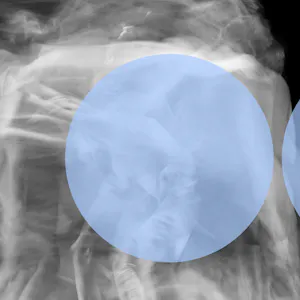
If you’re considering an automated threat intelligence service, it’s important to first weigh up the benefits and limitations against the level of security your business needs.

Artificial intelligence (AI) continues to rapidly evolve, unlocking incredible opportunities, but at the same time exposing companies and the public to unprecedented risks.